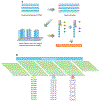Exome/Genome Sequencing in Undiagnosed Syndromes
- PMID: 36706750
- PMCID: PMC10483513
- DOI: 10.1146/annurev-med-042921-110721
Exome/Genome Sequencing in Undiagnosed Syndromes
Abstract
Exome sequencing (ES) and genome sequencing (GS) have radically transformed the diagnostic approach to undiagnosed rare/ultrarare Mendelian diseases. Next-generation sequencing (NGS), the technology integral for ES, GS, and most large (100+) gene panels, has enabled previously unimaginable diagnoses, changes in medical management, new treatments, and accurate reproductive risk assessments for patients, as well as new disease gene discoveries. Yet, challenges remain, as most individuals remain undiagnosed with current NGS. Improved NGS technology has resulted in long-read sequencing, which may resolve diagnoses in some patients who do not obtain a diagnosis with current short-read ES and GS, but its effectiveness is unclear, and it is expensive. Other challenges that persist include the resolution of variants of uncertain significance, the urgent need for patients with ultrarare disorders to have access to therapeutics, the need for equity in patient access to NGS-based testing, and the study of ethical concerns. However, the outlook for undiagnosed disease resolution is bright, due to continual advancements in the field.
Keywords: Mendelian diseases; exome sequencing; genome sequencing; next-generation sequencing; rare/ultrarare diseases; undiagnosed diseases.
Figures

Similar articles
-
Diagnostic yield of exome and genome sequencing after non-diagnostic multi-gene panels in patients with single-system diseases.Orphanet J Rare Dis. 2024 May 24;19(1):216. doi: 10.1186/s13023-024-03213-x. Orphanet J Rare Dis. 2024. PMID: 38790019 Free PMC article.
-
Exome and genome sequencing in a heterogeneous population of patients with rare disease: Identifying predictors of a diagnosis.Genet Med. 2024 Jun;26(6):101115. doi: 10.1016/j.gim.2024.101115. Epub 2024 Mar 1. Genet Med. 2024. PMID: 38436216 Free PMC article.
-
Limitations of exome sequencing in detecting rare and undiagnosed diseases.Am J Med Genet A. 2020 Jun;182(6):1400-1406. doi: 10.1002/ajmg.a.61558. Epub 2020 Mar 19. Am J Med Genet A. 2020. PMID: 32190976 Free PMC article.
-
Implementation of Exome Sequencing to Identify Rare Genetic Diseases.Methods Mol Biol. 2024;2719:79-98. doi: 10.1007/978-1-0716-3461-5_5. Methods Mol Biol. 2024. PMID: 37803113 Review.
-
Case for genome sequencing in infants and children with rare, undiagnosed or genetic diseases.J Med Genet. 2019 Dec;56(12):783-791. doi: 10.1136/jmedgenet-2019-106111. Epub 2019 Apr 25. J Med Genet. 2019. PMID: 31023718 Free PMC article. Review.
Cited by
-
Assessing the diagnostic impact of blood transcriptome profiling in a pediatric cohort previously assessed by genome sequencing.NPJ Genom Med. 2025 Jul 1;10(1):51. doi: 10.1038/s41525-025-00505-4. NPJ Genom Med. 2025. PMID: 40593860 Free PMC article.
-
Genetic resonance: dissecting the heritability and genetic correlations of human hearing acuity.G3 (Bethesda). 2025 Feb 5;15(2):jkae292. doi: 10.1093/g3journal/jkae292. G3 (Bethesda). 2025. PMID: 39663846 Free PMC article.
-
Deciphering the Complexity of FSHD: A Multimodal Approach as a Model for Rare Disorders.Int J Mol Sci. 2024 Oct 11;25(20):10949. doi: 10.3390/ijms252010949. Int J Mol Sci. 2024. PMID: 39456731 Free PMC article. Review.
-
Extracellular Vesicles as a Potential Therapy for Stroke.Int J Mol Sci. 2025 Mar 28;26(7):3130. doi: 10.3390/ijms26073130. Int J Mol Sci. 2025. PMID: 40243884 Free PMC article. Review.
-
Advancing Genetic Testing in Kidney Diseases: Report From a National Kidney Foundation Working Group.Am J Kidney Dis. 2024 Dec;84(6):751-766. doi: 10.1053/j.ajkd.2024.05.010. Epub 2024 Jul 19. Am J Kidney Dis. 2024. PMID: 39033956 Review.
References
-
- Eurordis. 2005. Rare Diseases: Understanding This Public Health Priority. Paris, France: Eur. Organ. Rare Dis. https://www.eurordis.org/wp-content/uploads/2009/12/princeps_document-EN...
-
- Kumar P, Radhakrishnan J, Chowdhary MA, Giampietro PF. 2001. Prevalence and patterns of presentation of genetic disorders in a pediatric emergency department. Mayo Clin. Proc 76:777–83 - PubMed
-
- Shashi V, McConkie-Rosell A, Rosell B, et al. 2014. The utility of the traditional medical genetics diagnostic evaluation in the context of next-generation sequencing for undiagnosed genetic disorders. Genet. Med 16:176–82 - PubMed
-
- Christianson A, Howson CP, Modell B. 2006. March of Dimes global report on birth defects: the hidden toll of dying and disabled children. Rep., March of Dimes Birth Defects Found., White Plains, NY
Publication types
MeSH terms
Grants and funding
LinkOut - more resources
Full Text Sources
Medical
Molecular Biology Databases

